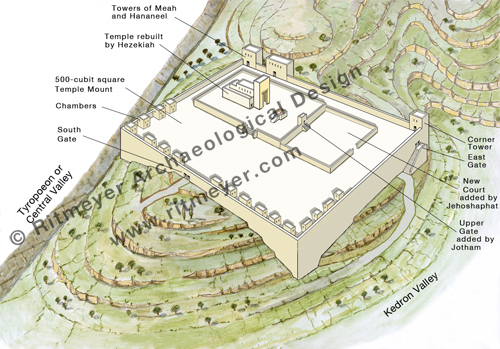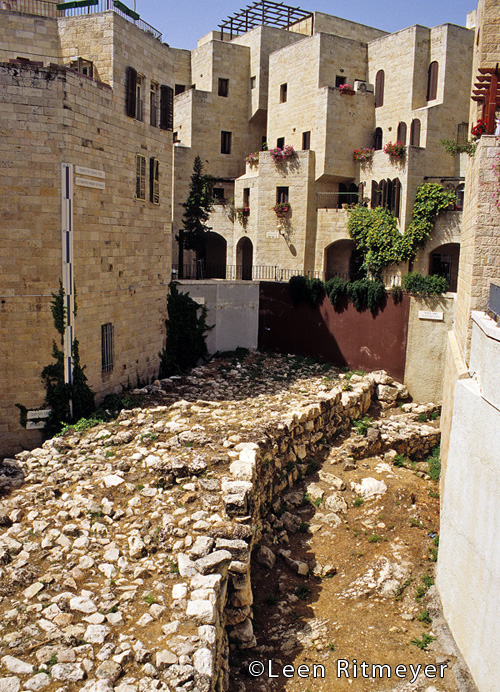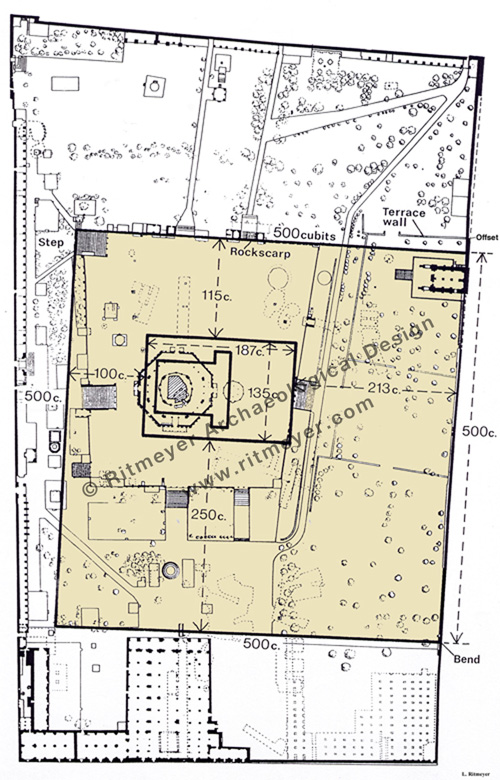The next drawing in our series dealing with the development of Mount Moriah and the Temple Mount shows what it would have looked like in the time of the later kings of Judah.

The first and original drawing showed what the mount looked like before anything was built on it. The next one showed Mount Moriah during the time of the Jebusites. This was followed by a drawing of Solomon’s Temple complex.
From the Hebrew Bible we know that Hezekiah (725–697 BC) was a good king, but he lived in difficult times. The Assyrians under Sennacherib had invaded the northern part of the country and many refugees had fled to Jerusalem and settled on the Western Hill of Jerusalem, as the Eastern Hill was already bursting at the seams.
Archaeology has given us a great insight into the kingship of Hezekiah, and has shown that he was one of the greatest builders Jerusalem has ever seen. In the Jewish Quarter of the Old City of Jerusalem one can visit the Broad Wall (mentioned later on in Nehemiah 12.38) that was built by Hezekiah to protect the new settlement. The excavations have shown that some houses had been dismantled to make room for this massive 7m (23ft) wide wall that encircled the Western Hill. This building work is mentioned in Isaiah 22.10, “you counted the houses of Jerusalem, and you broke down the houses to fortify the wall.”

Another great work mentioned in Isa. 22.11 is the construction of Hezekiah’s Tunnel. Hezekiah diverted the waters from the Gihon Spring and “sent” them through an underground tunnel to the Siloam Pool (Siloam – shiloah in Hebrew – means “sent”). One of the most exciting experiences one can have in Jerusalem is to walk through this ancient tunnel.


Hezekiah also embarked on a major rebuilding program of the Temple, as reflected in the second and later account of the Temple construction in 2 Chronicles 3–4. We believe that this text describes a virtually new and much larger Temple built by Hezekiah.
In this passage, the two columns of the Porch are described as being 35 cubits high in contrast to a height of 18 cubits mentioned in 1 Kings 7. Instead of the three-story-high wooden construction that was built around Solomon’s Temple, there is now an Upper Chamber above the original sanctuary. Other differences between the two descriptions show that Hezekiah not only rebuilt Solomon’s Temple, but also redesigned it. Nevertheless, this Temple is still referred to as the First Temple that was destroyed by the Babylonians in 586 BC.

har habbayit. This measurement of 500 cubits has been preserved in the text of Mishnah Middot 2.1: “The Temple Mount (har habbayit) measured five hundred cubits by five hundred cubits.”

Dear Dr. Ritmeyer,
You mention in this article that 2 Chronicles 3–4 refers to King Hezekiah being responsible for rebuilding King Solomon’s Temple, but in the New International Version (NIV) it is stated that it’s King Solomon who is building his original Temple.
Paragraph 15 “For the front of the temple he made two pillars, which together were thirty-five cubits[i] long, each with a capital five cubits high.” That reads to me as each pillar was 17.5 cubits long & with a capital of 5 cubits, so when erected were 22.5 cubits tall. It does not read to me as you put it: “the two columns of the Porch are described as being 35 cubits high in contrast to a height of 18 cubits mentioned in 1 Kings 7.”
https://www.biblegateway.com/passage/?search=2%20Chronicles%203
In the Second Degree Tracing Board address to the candidate, those pillar heights are described as being seventeen cubits & a half each, their circumferences twelve, their diameters four (it should be 3.82). They were formed hollow & cast in the plain of Jordan between Succoth & Zeredathah. They were adorned with two chapiters, each five cubits high & thus match the description in 2 Chronicles 3,
In 2 Chronicles 4, King Solomon is mentioned by name rather than King Hezekiah in paragraphs 18 & 19, so I would appreciate some clarification please.
Yours truly
Perry
Perry,
The word “together” is not in the Hebrew text. The ESV for example translates this verse as: “iIn front of the house he made two pillars thirty-five cubits high, with a capital of five cubits on the top of each.”, which is correct. Apart from the height of the columns, there are many differences with the text in 1 Kings 6 and 7. I have tabulated these differences in my book The Quest, p.306. The description in 2 Chronicles was written during or after the Babylonian Exile and therefore reflects the Temple building that was destroyed by the Babylonians. The fact that the Eastern Wall of the Temple Mount shows masonry from the 8th century BC, fursther shows that the Temple Mount was extended in that time.
One must be careful when reading the name of Solomon to ascribe that event of building to the actual King Solomon himself. In John 10.23 and Acts 5.12, Solomon’s Porch is mentioned. It would be misleading to suggest that this portico was built by Solomon himself, as it would contradict the description of the destruction of Jerusalem and its Temple in 586 BC. If any structure was older than the one built in their time, the ancients simply referred it to David or Solomon.
Another example: Herod’s Temple is called the Second Temple, but technically that is incorrect as it was at least the third temple building built on Mount Moriah (Solomon’s, Jeshua and Zreubbabel’s and Herod’s).
Dr. Ritmeyer,
As you pointed out, there are many versions of the Bible. In 5 of them, the height of KST is put at 120 cubits, but Barnes’ Notes on the Bible reads:
The height was an hundred and twenty cubits – This height, which so much exceeds that of the main building 1 Kings 6:2, is probably to be corrected by the reading of the Arabic Version and the Alexandrian Septuagint, “twenty cubits.” But see 2 Chronicles 3:9.
http://biblehub.com/nasb/2_chronicles/3-4.htm
These are my thoughts. To cast two hollow columns in molten brass, with a circumference of 18 feet & 52.5 feet tall, without the chapiters & cast in the cold ground seems to be asking too much of the technology 3,000 years ago. The brass would not flow well enough to fill the moulds. I doubt if a modern foundry could carry out such a task. I have not found any other references that Hezekiah is to be conflated with Solomon, apart from your assertion. I would be grateful if you would direct me to the evidence you found please.
Thank you,
Perry